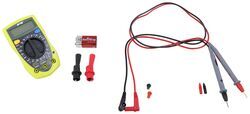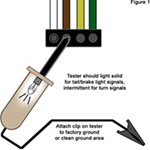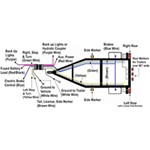
Troubleshooting Aluminum Trailer Wiring with a Multimeter
Updated 05/03/2019 | Published 05/02/2019
Question:
Troubleshooting with a multitester I had a Curt car wiring harness purchased from etrailer professionally installed after I had trouble with all the plastic underbody. I installed the lights on my aluminum foldup trailer myself. It worked well for about a year, all of a sudden no lights work. I have a multi meter to test with. I have seen the question about testing the car installation with the dc side set to 20v. How do I test the trailer side?
asked by: Brad
Expert Reply:
Using a multimeter like # PT89ZR set to the 20V setting will work well as you stated for the vehicle side because there is already a 12V power supply. To test a trailer you have a couple of different options to provide that power needed for testing; you can connect it to a vehicle that you've already confirmed has trailer wiring that works correctly or you can use a battery to supply 12V power to each wire function on your trailer individually. By adding power to the trailer harness, you can then test for power at your light connections to ensure power is getting to the lights.
Many trailers especially aluminum trailers have difficulty with the ground wires. If the ground wire connection goes bad, the lights will not work, so I recommend checking your ground connections to ensure they have a bare metal to metal connection. If you run a jump wire and ground to the battery and everything works, then you know the issue is the ground connection and a short in wiring. Tail lights often have their own ground wire or are grounded through their mounting hardware, so you will also want to make sure those connections are good. Some aluminum trailers will require a singular ground connection point and all ground wires run to that location.
I've attached a couple of articles to help with the wiring and troubleshooting if you need more assistance.

Product Page this Question was Asked From
Digital Multimeter with 42" Long Test Leads - LED Display
- Electrical Tools
- Testers
- Multimeter
- Yellow
- Performance Tool
more information >
Featured Help Information
Instructions
Miscellaneous Media

Continue Researching
- Search Results: akebrk~6
- Q&A: How to Test the Motor on a Set of Kwikee Electric Steps
- Q&A: Fuse Location In The Furrion RV Backup Camera
- Q&A: Troubleshooting Fan Blades Not Turning on MaxxFan Deluxe Roof Vent
- Q&A: How To Test The Control Module Of A Kwikee Electric RV Step
- Q&A: Troubleshooting Kwikee Steps Not Responding to the Override Switch
- Q&A: Trailer Brakes are Very Weak Even After Adjusting Them
- Q&A: Troubleshooting An Everchill RV Refrigerator That Wont Get Cold
- Article: Trailer Wiring Diagrams
- Article: Testing Trailer Brake Magnets for Proper Function
- Article: Wiring Trailer Lights with a 7-Way Plug (It's Easier Than You Think)
- Article: Rust Prevention
- Article: My Trailer Hitch Doesn't Fit
- Article: Trailer Maintenance Schedule
- Article: Brake Controller Installation: Starting from Scratch







